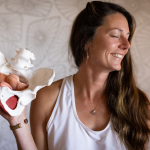
How Abdominal Massage Supports a Healthy Cycle and Manages Anxiety
Photo courtesy of author
Abdominal massage is a global practice that supports womb health and total-body healing. Learn how this practice can help manage anxiety and support a healthy menstrual cycle.
The abdomen is very rarely touched in a typical massage. However, abdominal massage is an ancient practice of healing, preventative medicine, and self-care that is performed worldwide.
Global Perspectives on the Abdomen
In the medical tradition of Japan, Hara refers to the soft belly.
Tan tien (Dantian) is a Chinese term identifying the energetic core of the body and the place where our physical and spiritual bodies meet.
A sobada de matriz, commonly referred to as a sobada in Mexican Spanish, is translated as “womb massage” and is still practiced throughout many historically Mayan lands today.
Chi Nei Tsang, or Thai-style abdominal massage treatments, involve using a gentle, soft yet deep touch to the abdomen to detoxify, tonify, and energize the internal organs to work more efficiently and to deal with unprocessed emotional energy.
How Abdominal Massage Enhances the Body’s Healing Capacity
Along with the rest of the body, the uterus, ovaries, and fallopian tubes are self-healing. When the tissues get congested or stagnant, our healing potentials atrophy.
Abdominal massage can move fluids and fascia to catalyze the body's self-healing systems. When blood, lymph, nerve communication, and energy flow powerfully and abundantly, internal organs can better heal and balance themselves. In fact, many invasive procedures can be avoided by practicing regular abdominal massages.
Abdominal massage is a gentle, non-invasive form of massage on the abdomen, low back, and sacrum. The techniques help reposition organs that have shifted and disrupted the flow of blood, lymph, nerve communication, and qi. Stimulating the liver specifically helps the female body process excess hormones and improves the elimination channel that is necessary for consistent, healthy menstrual cycles.
The Connection Between Qi and Anxiety
Anxiety can be correlated with qi stagnation in the system, or unprocessed emotions, which create dissonance in the female reproductive system. Anxiety is an emotion that has a particular resonance in the body, one that causes protection patterns, armoring, tension, and a general imprint of “caution.” When the body’s sympathetic nervous system is activated this way, the body de-prioritizes digestion and reproduction.
The blood is sent out away from the organs of the abdomen to power the limbs in case self-defense is necessary, causing the functions of the vital organs to slow and sometimes pause entirely. That’s why women sometimes stop menstruating altogether in times of stress.
If this anxiety pattern is sustained for long periods, it can result in stress-related fertility issues, unexplained infertility, tubal blockages, ovarian cysts, endometriosis, hormonal imbalances, menstrual irregularities, menstrual pain, PMS, fibroids, hot flashes, insomnia, incontinence, cystitis, constipation, diarrhea, bloating, IBS, headaches, low back pain, varicose veins, and more.
All of this can be remedied by the hands of a well-trained abdominal massage therapist, and even through self-massage. (Watch a 55-minute guided abdominal self-massage practice.) Doing abdominal massage can be a powerful way to encourage a womb cleanse, releasing stuck material from the uterus and unprocessed emotion from the Hara, thus refreshing reproductive and elimination pathways. It can ease menstrual cycle discomfort, balance menstrual and reproductive irregularities, boost fertility, and support postpartum healing. What better time than spring for such a cleanse?
Abdominal Massage With Infradian Rhythm Syncing
Regarding timing, women in their reproductive years benefit from abdominal massage in different phases of their cycles. Following a lifestyle and self-care routine that syncs with the menstrual cycle is also called infradian rhythm syncing. The infradian rhythm is a sister rhythm to the circadian rhythm, but instead of a 24-hour solar cycle, it's a 28-day lunar cycle.
The infradian rhythm affects female biology uniquely. As women learn to listen to how their bodies respond during different phases of the reproductive cycle, they become deeply connected to themselves and nature's rhythms.
Follicular Phase: Practice abdominal massage here to slowly and gently warm up the tissues, supporting the body’s production of follicle stimulating hormone (FSH), luteinizing hormone (LH), and estrogen. Optional: Precede abdominal massage with some gentle movement, including the rocking of the hips and rolling the spine.
Ovulatory Phase and First Half of Luteal Phase: Practice abdominal massage here to stimulate and clear stagnation in the Hara, support ovulation, and help the body produce progesterone. Optional: Move the body vigorously, getting the heart rate up for 20 minutes before lying down to massage.
Second Half of Luteal Phase and the Menstrual Phase: Practice abdominal massage here to support the down-regulation of energy toward the cocoon time of menstruation. Hormones are declining, and the liver especially needs support to keep the elimination pathways clear in order to process all those excess hormones. Touch should be very gentle and nurturing. Optional: Do some diaphragmatic breathing and gentle shaking to encourage lymph flow.
Pregnancy and Postpartum: It can be very grounding and soothing to stimulate the belly during pregnancy. It helps the tissues stretch, the body receives loving touch, and the endorphins created are shared with the baby.
Postpartum, this practice is essential in helping the uterus reseat properly inside the pelvis and to support hormone regulation, digestion, and overall nurturing. It is recommended in Ayurvedic medicine that postpartum women have 40 days of intensive postpartum care that includes abdominal massage every day.
Perimenopause and Menopause: Menstrual rhythms can begin to wobble throughout perimenopause, but practicing infradian syncing and abdominal massage according to the rhythms of the moon can help non-bleeding women feel connected to their rhythms. (Imagine the body bleeding with the new moon and ovulating with the full moon.)
Look for practitioners trained in these modalities, and remember that they sometimes are also massage therapists, doulas, midwives, energy therapists, and pelvic health specialists.










